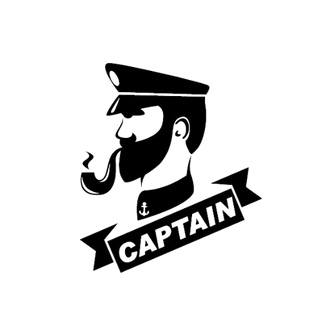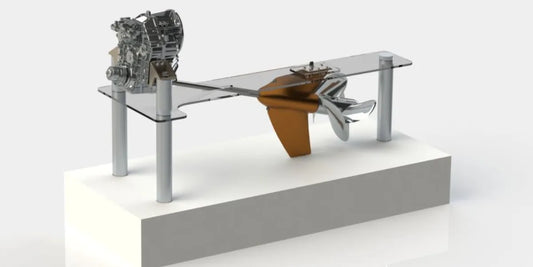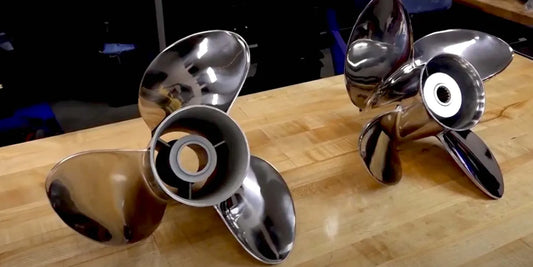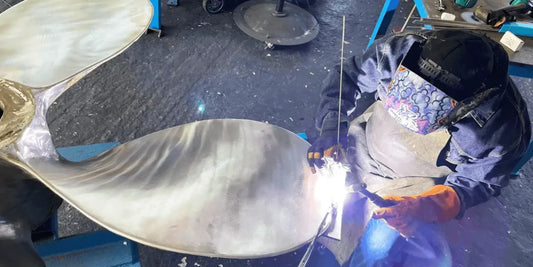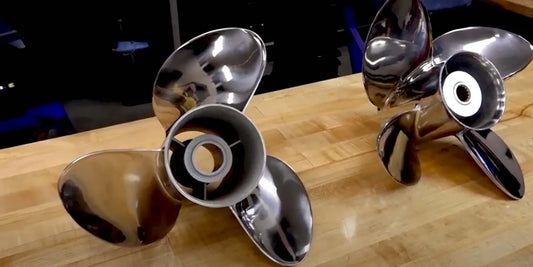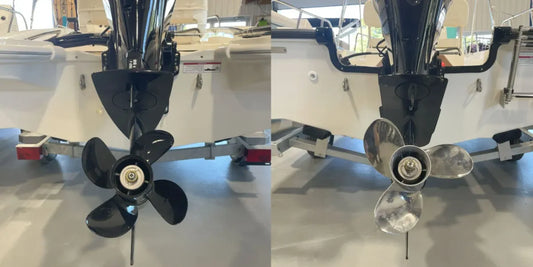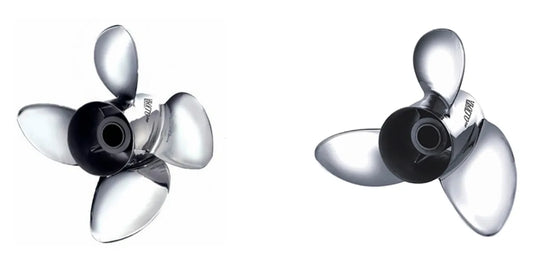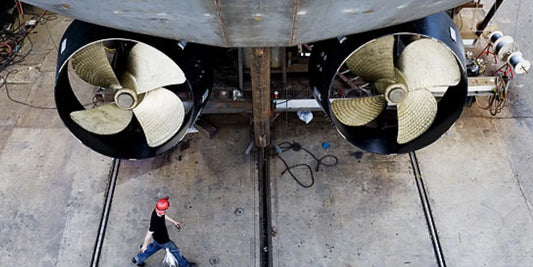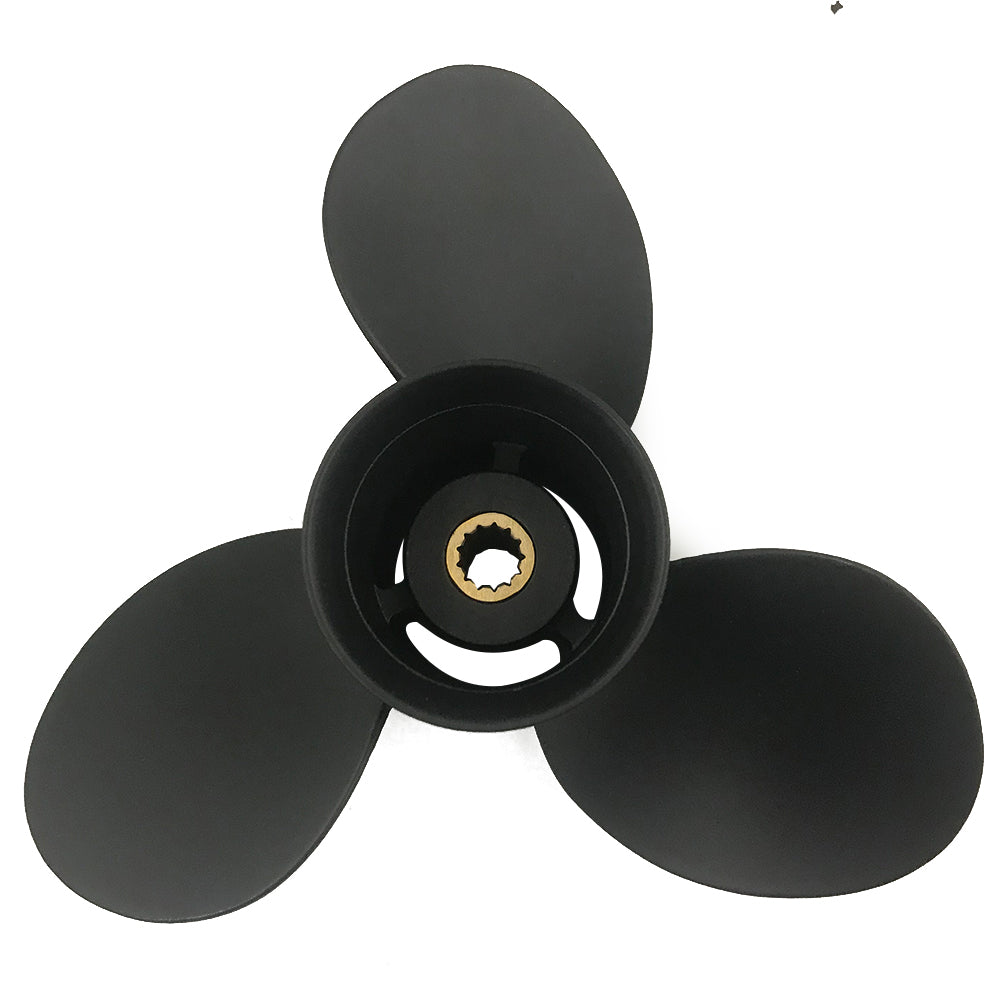Maritime operations very much depend on the performance of ship propulsion systems for their efficiency. A propeller, therefore, plays a crucial role in determining not only the speed and maneuverability of a vessel but also its fuel consumption. With fuel prices rising and regulatory aspects shifting towards stricter enforcement of carbon emissions, propeller dynamics have become a focal point for the shipping industry. This paper examines the interplay between propeller design, hydrodynamics, and fuel efficiency, providing insight into how advances in technology and engineering are transforming ship propulsion systems. Readers will gain a thorough understanding of the underlying principles of propeller performance and learn practical tips for enhancing fuel efficiency as we work toward a sustainable future.
Introduction to Ship Propellers

Definition and Importance of Ship Propellers
Ship propellers are mechanical devices that convert rotational energy into thrust, enabling vessels to move efficiently through water. Comprising a hub and several radial blades, propellers operate on the principle of Newton's third law of motion: the backward-pushed water exerts an equal and opposite forward force on the vessel, thus propelling it ahead. Parameters describing the geometry of blades, such as pitch, diameter, and skew factors, that have several effects on value serve as factors in determining thrust, power, efficiency, or cavitation resistance.
Ship propellers directly influence the efficiency of ships in their operations; hence, greater emphasis must be placed on them. It has been found that, through scientific studies in Marine Engineering, 70% to 90% of the energy used in propelling a ship is mainly dependent on the propeller's performance. Developments in materials and blade section design have strived to decrease hydrodynamic drag and improve fuel efficiency, a second criterion set to ensure that operational costs are kept to a minimum and that lax standards for pollution are not considered. Besides, emission regulations are becoming increasingly stringent, requiring more stringent design parameters for all propellers being designed, thus imposing the necessity to define solutions for sustainable shipping.
Types of Propeller Overview
In a marine propulsion system, propellers can be classified based on their design, manufacturing method, and operational efficiency. The most commonly used types are the fixed-pitch propeller (either an FPP or fixed-pitch propellers), the controllable-pitch propeller (CPP), the ducted propeller, and the contra-rotating propeller.
Fixed-Pitch Propellers (FPP): The fixed-pitch propeller, being a fixed-blade-angle mechanism, is designed to operate optimally under a specific set of conditions. Its mechanical simplicity and robustness have made the FPP the most popular choice for vessels with relatively steady operating profiles. Thus, it is not very useful where the load or speed varies because the pitch cannot be changed to suit variable conditions, making this type somewhat inefficient.
Controllable-Pitch Propellers (CPP): In these types of propellers, the blades' pitch can change dynamically in response to the vessel's speed, load, or specific maneuvering requirements. The change might assist in frequent speed adjustments, as needed by an icebreaker or a supply vessel. Hydraulic or mechanical means of controlling the pitch give better control over efficiency and fuel consumption.
Ducted Propellers (Kort Nozzles): These propellers are housed in a duct that perfects thrust production and reduces cavitation. Such propellers achieve their maximum efficiency by providing high thrust at low speeds, as required in a tugboat. The nozzle-hull profile maximizes propulsion efficiency and ensures better maneuverability under challenging conditions.
Contra-Rotating Propellers (CRP): In this system, two propellers with two sets of blades rotate in opposite directions on either a standard shaft or on coaxial shafts. This arrangement reduces rotational energy losses, resulting in higher thrust output and better fuel efficiency. CRPs are being increasingly adopted in modern vessels that aim to conserve energy and reduce greenhouse gas emissions.
Each type of propeller is designed to meet specific needs, taking into account parameters such as efficiency, noise, and environmental considerations. Design improvements continue to be made with ever-better CFD models and material engineers, thus extending the forefront of marine propulsion technology.
The Role of Propellers in Marine Propulsion Systems
The propellers are the ultimate means of converting the rotational energy generated in a ship's engine into thrust, propelling the boat forward. Thus, they operate according to the principle of fluid dynamics, whereby a pressure differential is created between the forward surfaces of the blades, referred to as "suction," and the rearward ones, referred to as "pressure." It is this thrust forward, proportional to the power transmitted by the engine and design-related parameters of the propeller, that determines the movement of the ship.
Modern propeller systems are designed with various innovations, such as optimized blade geometries, advanced materials like carbon fiber composites, and surface coatings that resist fouling and wear. These techniques and measures, for the efficient operation of the vessel, have been believed to enhance operational efficiency, with the study pointing out that a properly optimized propeller design may increase the propulsive efficiency by almost 15-20%, which may result in considerable savings in fuel costs through the lifetime of the vessel. Additionally, with the use of CPP, blade angles can be dynamically altered to provide better maneuverability and adaptability to varying load conditions, especially in scenarios where speed changes frequently.
Noise and vibration constitute two primary design considerations in modern propeller engineering. Cavitation-reducing designs are crucial in preventing structural deterioration and maintaining stealth profiles in naval and scientific applications. State-of-the-art computational modeling and tuning of blade shapes in relation to wake flow interactions account for vibrations induced by propellers.
Although propeller technology is constantly evolving toward greater efficiency, it also falls under the remit of maritime greenhouse gas emission reductions, as outlined in the IMO's decarbonization frameworks. Thus, these developments underscore the pivotal role of propellers in advancing sustainable marine propulsion.
Types of Propellers Used in Naval Vessels

Conventional Screw Propeller
The conventional screw propeller is the typical marine propulsion system and is considered the simplest design, touted for its high efficiency factor under diverse operating conditions. A typical propeller consists of several blades extending outward from a central hub made from a high-grade material, such as stainless steel or nickel-aluminum bronze. Functionally, the propeller converts rotational motion generated by the vessel's engine into thrust to push the boat forward.
Various modern developments in computational fluid dynamics and precision manufacturing have contributed significantly to the progressive enhancement of screw propellers over the centuries. Thus, through the optimization of correct blade pitch and skew, cavitation is reduced, and consequently, increased thrust efficiency is achieved. Cavitation occurs when pressure variations around the blade create vapor-filled cavities, known as "bubbles," which can erode the blades, generate noise, or cause energy loss. The recent trend is to minimize these effects through the use of special coatings on the blades and improved hydrodynamic shapes.
With the advent of new regulations coming into effect, which place a stricter emphasis on environmental sustainability, modifications to conventional screw propellers are being initiated. Studies have reported that incorporating energy-saving devices (ESDs), such as pre-swirl stators mounted upstream of the propeller, can reduce fuel consumption by approximately 8% under optimal conditions. Hence, the screw propeller becomes a key element in the greener setting of marine technologies, supporting international legislations such as the Energy Efficiency Design Index (EEDI).
Contrary to that discussed above, still, a conventional screw propeller remains one of those reliable, versatile, and indispensable technologies for naval and commercial ship propulsion that is continuously benefiting from scientific innovations to meet modern-day performance and environmental standards.
Controllable Pitch (CP) Propeller
Controllable Pitch (CP) propellers represent and define advanced propulsion technology, enabling vessels to change their blade pitch dynamically while in operation. Unlike fixed-pitch propellers with a predetermined blade angle, CP propellers provide optimal thrust and efficiency across a variety of speeds and operating conditions. This changeability of the blade angle is through either a mechanical or hydraulic mechanism in the hub, allowed by design.
The principal advantage offered by CP propellers is improved vessel maneuverability, especially in tight harbors or during dynamic positioning processes, where precision in control is indispensable. Furthermore, CP propellers maintain approximately the same propulsion near the operating speed, thereby conserving almost as much fuel and emissions. For example, when making variable-speed operations, they adjust the blade pitch to minimize hindrance and maximize hydrodynamic performance.
Advanced control systems can be integrated into modern CP propeller systems to enhance precision and responsiveness. The systems detect sea states and changing load conditions using a set of sensors, ensuring consistent performance. Moreover, CP applications also aid in complying with stringent environmental legislation by enabling vessels to operate efficiently within frameworks for energy savings, such as the Energy Efficiency Existing Ship Index (EEXI) and the IMO decarbonization target.
The new achievements in the CP propeller designs include lightweight composites and advanced hydrodynamic profiles for the blades. Such advancements serve to mitigate cavitation, noise, and vibration while maximizing thrust efficiency. Such is the beauty of CP propellers that they hold tremendous value in contemporary shipping, offering performance optimization and regulatory compliance as deemed necessary by the evolving trends of the maritime industry.
Alternative Innovative Propeller Designs
Various innovative designs have been proposed in the maritime industry to improve efficiency and sustainability. Among these are ducted propellers, which, when installed in a nozzle, provide increased thrust at lower speeds, to the advantage of tugboats and fishing boats. Investigations into ducted propellers suggest that they can significantly reduce energy consumption in specific operating profiles, thereby reducing fuel costs and emissions.
Another advanced design is the surface-piercing propeller, which has blades that operate partially above the water. This reduces drag and improves speed in high-performance applications, such as patrol and rescue boats. Contra-rotation propellers (two propellers mounted on the same shaft rotating opposite to each other) also improved by cutting down on rotational energy loss and optimizing wake flow.
More recently, tip-modified propellers have been developed with winglets or special endplates to counteract vortex formation at the tip. This results in a reduction of noise, vibration, and cavitation while increasing the efficiency of propulsion. CFD simulations and model tests provide continuous support for the iterative design process, helping engineers refine new propeller concepts to satisfy or focus on specific performance and environmental parameters.
Since its inception, this concept has served as a driving force behind the continuous advancements in propeller technology, aiming for operational efficiency and environmental sustainability in the maritime field.
Propeller Dynamics and Fuel Efficiency

The hydrodynamic principles at work for propellers
Hydrodynamic principles, i.e., chiefly govern the performance of a propeller; propeller blades interact with water to generate thrust. The blades, in rotation, create a pressure difference between the forward and aft sides, and a force arises that tends to move the vessel forward. There are essentially two laws that must be considered here: Newton's third law of motion, which states that every action must meet with an equal and opposite reaction. In contrast, Bernoulli's principle states that variations in fluid velocity result in corresponding variations in pressure.
Another critical factor lies within the concept of the advance ratio, a dimensionless parameter that gives an accurate quantitative relationship between the ship's motions in the longitudinal directions and the rotational speed of the propeller or the propeller diameter. This parameter allows engineers to study its efficiency under various operational conditions. Other factors affecting the operational aspects of the propeller include the blade geometry, specifically its pitch, skew, and rake, as well as the number of blades. Additionally, the propeller must pitch to generate sufficient thrust while minimizing cavitation and vibrational loads.
Between now and the present, modern scholars employing Computational Fluid Dynamics (CFD) studies illustrate the importance of optimizing the flow field around the propeller. The line of the blades may, therefore, reduce energy loss through turbulence and wake formation, as well as cavitation, where low pressure causes vapor bubbles to form and subsequently collapse, potentially causing damage to the blades. Advanced material technologies, therefore, further enhanced performance by allowing the creation of thinner, more efficient blade profiles that can sustain high stresses.
Thoughts on hydrodynamic efficiency consider minimizing engine power. Because fuel consumption and emissions are directly proportional to power output, further results are savings on fuel and emissions. To maximize propulsion performance, drag can be lowered by modifying blade section shapes and applying special surface coatings. In fact, through research and development, and advances in technology, the development of high-efficiency propellers continues to revolutionize marine propulsion in accordance with stricter international regulations on fuel efficiency and environmental sustainability.
Blade Shape-Effect on Efficiency
The geometry of the propeller blade is a crucial element that enhances the hydrodynamic efficiency of the vessel. Blade shape influences the pressure and velocity field distribution around the propeller, which in turn yields thrust and may cause the dissipation of valuable energy. The level ratio of the blade also influences cavitation-the higher the aspect ratio (ratio of blade length and width), the lesser cavitation exists, and consequently, that of efficiency is favored with better fluid flow mechanism. Moreover, a variable pitch, along with the radius, will permit variable performance optimization under varying operating conditions, such as changes in speed requirements/load requirements.
Since elliptical blade tips effectively suppress tip vortices, their primary source of drag and power loss in propulsion systems, establishing the relationship between these produces sets of blade detail configurations through Computational Fluid Dynamics (CFD) and towing tank experimentation. Additionally, innovative skewed designs effectively suppress pressure fluctuations and vibrations, thereby reducing wear on the propulsion system and extending operational life. Quantitative surveys indicate that advanced design can enhance overall propeller efficiency by 10 to 15%, thereby ensuring fuel economy and compliance with environmental regulations. Thus, a strong justification can be made for selecting blade shapes in the modern field of maritime engineering.
Aftship-Type Solutions for Increased Performance
After-ship solutions optimize vessel performance in terms of fuel consumption, hydrodynamic stability, and operational reliability. Modern technological advances have introduced innovative features, such as energy-saving devices, optimized hull forms, and advanced types of rudders, all designed to reduce hydrodynamic drag and enhance propulsion efficiency. For instance, thrust fins and pre-swirl stators are intended to manipulate the water flow in a manner that utilizes the rotational energy from the propeller to generate additional thrust. Research has revealed that ESDs, when integrated into a vessel hull, can reduce fuel consumption by approximately 5-8%, making them of paramount importance in meeting stringent emission norms, such as the IMO’s EEXI and CII requirements.
Moreover, computational fluid dynamics (CFD) modeling has streamlined the aftship component design processes following the precise implementation of CFD, enabling the running of solutions with utmost efficiency. CFD simulations would allow engineers to investigate flow patterns, mitigate cavitation effects, and determine the optimal configuration, long before physical testing can be carried out. This approach ensures that components like twisted rudders and bulbous stern tubes are designed to minimize energy losses, thereby enhancing efficiency. Together, these technologies note the realm of efficient and environmentally friendly solutions.
Maintenance and Care for Ship Propellers

Regular Inspection and Maintenance Practices
Regular inspection and maintenance of ship propellers ensure their proper operation and prevent any long-term structural impairments. Such inspections look for surface irregularities, such as cracks, dents, and biofouling, and there is a possibility of decreased propeller efficiency, which will likely lead to an increase in fuel consumption. The ultrasonic and dye-penetrant testing methods are some of the advanced techniques for detecting minute flaws that may be invisible to the naked eye. Another vital aspect is monitoring the propeller shaft's alignment to ensure balanced operations, as any misalignment would induce vibration and wear.
Cleaning the underwater surface of the propeller to eradicate marine growth or deposits is a great starting point whenever the problem is fouling, as it severely compromises hydrodynamic efficiency. Another maintenance measure is keeping the blades well-polished, which results in a reduction in surface roughness and further reduces energy losses. Also, anti-fouling coatings help reduce the accumulation of biofouling over time, thus extending the intervals between cleanings. For inspection and maintenance on modern vessels, predictive maintenance practices such as vibration analysis and digital condition monitoring enable early detection of issues. By utilizing real-time data, these systems allow pinpoint intervention strategies, thereby avoiding unnecessary repairs and costly operational downtime. When carried out at regular intervals, this extends the life and efficiency of the propellers while also aligning with maritime sustainability.
Key Issues and Their Solutions in Propeller Maintenance
When it comes to propeller maintenance, cavitation damage is a widespread problem. The bubbles form because of differences in water pressure, and they collapse on the blades at times, causing pitting and erosion. To prevent such situations, I'd ensure that the propeller correctly fits the operating conditions of the vessel. For example, I may examine pitch, diameter, and blade design to minimize stress and enhance hydrodynamic efficiency. Regular surface inspections and refinishing of the propeller will also help prevent progressive erosion from cavitation.
Another recurring problem I face is biofouling, as marine organisms such as barnacles and algae can adhere to the propeller surface. With all this hatred sitting on the propellers, they create drag, which reduces the vessel's speed and fuel efficiency. I select the right antifouling coating and cleaning procedure to keep the blades clear of any biological deposits. Furthermore, I arrange for another dive or dry dock to assess and service the propellers, ensuring they remain in top service.
Ultimately, my observations frequently highlight vibration-propagation issues stemming from poorly aligned or imbalanced propellers, which accelerate the wear and tear on the entire propulsion system. Solutions to this question include conducting delicate balancing and alignment checks using state-of-the-art instrumentation equipment. I can enhance the overall performance and operational reliability of vessel-propulsion systems by addressing these issues systematically and promptly.
Innovative Technologies in Propeller Care
The maritime industry is adopting advanced technologies for propeller maintenance to achieve greater efficiency, reduce downtime, and ensure long-term sustainability. One such technology is the use of AI and ML-based predictive maintenance systems that collect real-time data from vibration sensors, acoustic monitors, and torque measurements, helping engineers identify potential defects in their early stages. By learning from standard patterns and anomalies, these AI-derived tools can predict maintenance schedules with utmost accuracy, essentially minimizing unplanned repairs and disruptions to operations.
Another breakthrough from this domain involves the usage of advanced materials and surface treatments for propellers. Adding modern coatings, such as those containing graphene or ultra-low-friction compounds, will significantly enhance the resistance of surface areas to marine biofouling and corrosion. In turn, these improvements also enhance the hydrodynamic performance of the propeller, reduce fuel consumption, and, to some extent, mitigate its associated greenhouse gas emissions. When combined with 3D printing, this approach provides a more streamlined method for bringing life to highly specialized and lightweight propeller designs, enabling on-demand manufacture and greater customization tailored to exact vessel needs.
Digital twin technology is also transforming propeller maintenance. By generating a detailed virtual model of the propeller system, digital twins can simulate performance extensively under various operating conditions. Engineers can use digital twins to analyze optimal arrangements, stress tolerances, and design variations from a remote location. Combined, these technologies take a proactive stance in maritime operations, thus adhering to global standards for energy efficiency and reduced environmental impact.
Future Trends in Propeller Technology

Advancements in Propeller Design and Materials
From my perspective, the evolution in propeller design and materials represents one of the significant forces driving the maritime industry towards greater efficiency and sustainability. I have observed a notable trend: a growing consideration of the use of computational fluid dynamics in defining propeller geometries. The CFD approach can simulate and analyze the flow of water around blades, allowing for the design of a structure that maximizes thrust with the lowest possible energy losses and cavitations. This unprecedented precision has enabled modern propellers to be more efficient and virtually noiseless as well; noise is another environmental concern, including noise pollution in the marine environment.
Material engineering is yet another area in which I witness a significant transformation in propeller design today. The enhancement in propulsion performance achieved with lightweight, high-strength materials, such as carbon fiber composites and advanced alloys, is quite significant. Resistance to corrosion and fatigue is the primary concern in marine environments, and these materials are best suited for the purpose. The lesser weight of the materials means that vessels can be more fuel-efficient, which in turn reduces greenhouse gas emissions. All these developments link to the balance between fuel economy and sustainability, a topic increasingly under consideration worldwide, opening an evolutionary track for propellers based on performance and in line with stringent environmental requirements.
In addition, IIC considers additive manufacturing, also known as 3D printing, to be one of the technologies believed to be changing the face of propeller manufacturing. This technology enables the fabrication of highly customized and complex propeller shapes that are previously impossible to manufacture using traditional methods. It also collapses time scales into very favorable terms, thereby bestowing on the environmental issue the virtues of green economics. In principle, then, this technology, with improvements in both design methods and material technologies, promises a future in which propeller technology will offer very advanced solutions for the new maritime agenda.
Integrating Propulsion Systems with Green Technologies
In my view, coupling propeller systems with green technology is a link in the chain to a sustainable maritime industry. The best way forward is to ensure that propeller systems work in conjunction with renewable energy production methods, including wind-assisted propulsion and hybrid electric engine options. Maximizing hydrodynamic performance by leveraging modern computational models would enable propeller systems to integrate with green technologies, thereby reducing energy loss and resulting in lower fuel consumption.
The materials have a great deal to say in this precise integration. Considering the lighter-weight composites that resist corrosion and are formed from the environment's perspective, the vessel's gross weight can be minimized in support of energy efficiency. The monitored data analysis, provided in real-time, is the final step in designing a smart propeller that facilitates optimized performance under varying environmental conditions, leading to fuel savings and emission reductions. These technological advances arise not from mere legislative mandates for decarbonization but lead the way for green maritime conduct.
A well-conceived integration of propeller systems and green technology must be promoted if significant reductions in marine vessel carbon footprints are to be achieved all while ensuring that they operate at their performance and reliability peak. Forward-thinking approaches addressing the environmental challenges encountered on the maritime front will lay the foundation for a sustainable future in the global shipping arena.
Trends and Market Opportunities in Propeller Solutions
In my view, the market for propeller solutions is undergoing a significant transformation largely due to the combined effects of sustainability and performance. The trend is toward more energy-efficient designs: highly skewed, with more blades to decrease hydrodynamic resistance and consequently fuel consumption. State-of-the-art computational fluid dynamics simulations accompany advanced designs, thus allowing manufacturers to optimize performance precisely. There are also greater interests in lightweight materials such as composite and hybrid alloys which may provide the advantage of weight reduction without compromising strength and hence efficiency gains.
Another evident trend is the combination of propeller systems with other propulsion systems, such as hybrid and electric engines. These arise due to increasingly stringent regulations against emissions promulgated by the International Maritime Organization (IMO), which allow for potential innovative collaborations between propulsion engineers and energy system manufacturers. Smart technologies, in the meantime, continue to carve out a larger role for themselves, while sensors and real-time analytics allow for adaptive performance management and predictive maintenance, which, in turn, reduce downtime and maintenance costs for operators while improving further operational efficiency.
Generously endowed with opportunities, the market awaits stakeholders who are willing to harness these technological advancements. Companies that support sustainability are in alignment with ever-evolving regulatory frameworks, heed the call from customers for solutions that improve operational efficiency and are reliable, and stand to reap a considerable market share. Through R&D, multi-sector collaborations, and investments in green innovations, we not only address the needs of current-day markets but also pave the way in shaping the future market for marine propulsion systems.
Reference Sources
-
Understanding the Crucial Role of the Propeller System - Discusses how optimized propeller design reduces fuel consumption and enhances vessel performance.
-
The Critical Role of Propeller Efficiency and Tuning - Explores the importance of propeller tuning for maximizing marine performance.
-
An Efficiency Optimizing Propeller Speed - A study on how inflow velocity fluctuations can improve propulsion efficiency.
-
Basic Principles of Ship Propulsion - A comprehensive guide on propulsion principles and energy efficiency measures.
-
Improving Fuel Efficiency of a Boat by Retrofitting Propeller - Details a case study on retrofitting a boat with a larger propeller for better fuel efficiency.
Frequently Asked Questions (FAQs)
These are two questions MOST asked in addition to the above question?
In general, a propeller or a ship propeller is considered a rotating device that generates thrust by converting rotational motion imparted by the main engine. It consists of several components, including the blades, the hub, and the shaft. The shape of the propeller is crucial because the blade shape and pitch significantly impact the efficiency of the propulsion force. When rotated by the engine, the propeller blades cause a pressure difference that produces thrust, forcing the hull of the ship through the water. Different types of propellers are used in the marine industry, depending on the specific requirements of a particular vessel, including fixed-pitch and controllable-pitch propellers.
What types of propellers are there?
The marine industry utilizes several types of propellers, classified under the marine set, for various propulsion requirements. A fixed-pitch propeller has blades set at a fixed angle, rendering it optimized for a specific type of performance. Conversely, a controllable pitch propeller varies the pitch to apply the best thrust and power efficiencies. Ducted propellers lie in ducts; they render the performance somewhat better, and also noiseless. A naval propeller is the one used for military vessels, often referred to as the death of engine tolerance from the steward's side. There are many types of propellers with which one must identify a ship's proper propulsion system.
How does cavitation affect propeller performance?
To go into detail, cavitation occurs whenever the pressure on the blade side drops below the vapor pressure of water, resulting in the formation of bubbles. With the collapse of these bubbles, they can inflict considerable damage on the propeller blades, thereby affecting the overall efficiency. This pressure difference can lead to a reduction in exerted thrust and the onset of vibrations, both of which affect the vessel's stability. Proper propeller design and maintenance are crucial to mitigating the cavitation phenomenon and optimizing propulsion efficiency. Regular inspections of the propeller and hull can help identify any issues that may promote cavitation.
What is propeller maintenance-denoting conceptualization?
The concept of propeller maintenance provides insight into the regular inspection and servicing of the propeller and its components, enabling optimal performance and maximizing its lifespan. This includes investigating whether there are any signs of wear from damage, cavitation effects on the blade, and buckling in the hub. The maintenance also includes cleaning of the propeller to remove marine growth and debris that hampers its performance. Proper alignment of the propeller shaft is essential because incorrect alignment tends to increase vibration and wear. If such maintenance is done proactively, one could render the propulsion system to perform better and prolong the life of the propeller.
How does the pitch of a propeller influence its performance?
The pitch of a propeller refers to the angle of the blade and directly affects how efficiently the propeller can propel a ship. High pitch means the propeller moves more water per revolution, generating greater thrust and speed. Low pitch, on the other hand, tends to offer better acceleration but may limit the top speed. Different vessels require different pitch settings—thus, fixed-pitch propellers have a fixed angle for all conditions, while controllable-pitch ones have a variable angle depending on the operational conditions. So, any designer or operator of a ship propulsion system must know about the pitch-performance relation.
What are the components of the propeller?
The main components of a ship's propeller are the blades, hub, and shaft. The blades typically have a helical form to facilitate efficient water displacement. The hub serves as a connection between the blades and the propeller shaft, which transmits the power received from the main engine. Other crucial components include the thrust shaft, which transmits thrust to the ship, and the body that attaches to the propeller to maintain its structural integrity. Each part contributes to the optimum performance of the propulsion system, while their regular check and maintenance will ensure the parts function properly.
